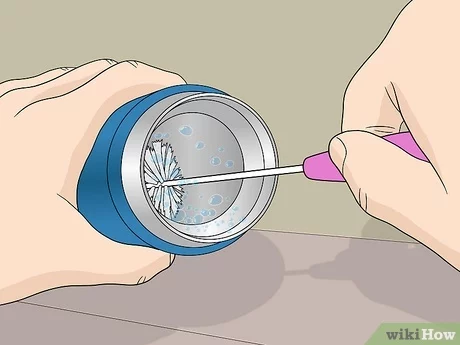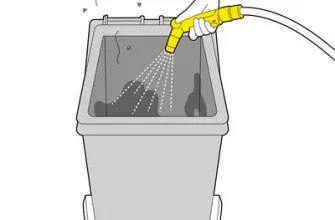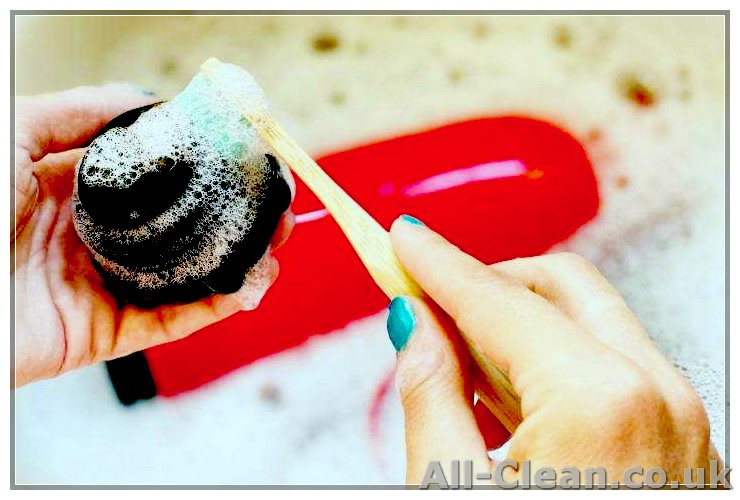
Whether you use your flask every day or just once in a while, it’s important to keep it clean and fresh. Over time, flasks can develop a buildup of residue, limescale, and bacteria. Luckily, there are several easy and effective ways to clean your flask with common household ingredients.
If you’re looking for a quick and easy cleaning method, bicarbonate of soda (also known as baking soda) is an excellent option. Simply fill your flask with warm water, add a spoonful of bicarbonate of soda, and give it a good shake. The bicarbonate of soda will help break down any residue and odors, leaving your flask fresh and clean.
Rice is another natural and affordable cleaning solution for flasks. Just pour a handful of uncooked rice into your flask, add some warm water, and give it a good swirl. The rice will act as a scrubbing agent, loosening any stubborn residue. Once you’re done, simply rinse the flask out with water and it will be good as new.
Vinegar is a versatile and effective cleaning agent that you probably already have in your kitchen. To clean your flask with vinegar, mix equal parts vinegar and water in a bowl or sink. Fill your flask with the solution and let it sit for several minutes. The vinegar will break down limescale and sanitize the flask. Afterward, give the flask a thorough rinsing and it will be ready to use again.
It’s important to note that some flasks may require a little more care when it comes to cleaning. For example, if your flask has a glass or metal lining, avoid using abrasive substances like rice or vinegar, as they may scratch or damage the lining. Instead, opt for a gentle soap and warm water solution, or consider using denture cleaning tablets specifically designed for cleaning flasks.
When it comes to cleaning insulated flasks, it’s best to stick with warm, soapy water and avoid harsh chemicals or high temperatures that could damage the insulation. Insulated flasks often have a smaller opening, so using a long-handled brush or bottle cleaner can help you reach all the nooks and crannies.
Regardless of which method you choose, always be sure to give your flask a thorough washing and drying before using it again. Leaving any liquid or residue inside the flask for an extended period of time can lead to the growth of bacteria or mold. To ensure the long-term cleanliness of your flask, it’s a good idea to wash it by hand rather than using a dishwasher, especially if it’s not dishwasher-safe.
By following these easy and effective cleaning methods, you’ll be able to enjoy clean and fresh flasks for years to come. Incorporating regular cleaning into your flask maintenance routine will not only eliminate unwanted odors and limescale, but it will also keep your flask looking its best and ensure the safety of your beverage every time you use it.
- Methods to Clean a Flask
- Bicarbonate of Soda (Baking Soda)
- Vinegar
- Rice
- Using Bicarb to Clean a Flask
- Gather the Ingredients
- The Cleaning Process
- Using Rice to Clean a Flask
- Using Vinegar to Clean a Flask
- Thermos: Over 100 Years of Expertise
- Use Baking Soda and Vinegar
- Try Denture Tablets
- Use Rice or Salt
- Additional Tips
- Video:
- How to clean sieve / clean tea strainer /metal sieve cleaning
Methods to Clean a Flask
Cleaning a flask can be a challenging task, especially when it comes to removing stubborn stains and limescale buildup. However, there are several methods that you can use to effectively clean your flask and keep it in pristine condition for years to come.
Bicarbonate of Soda (Baking Soda)
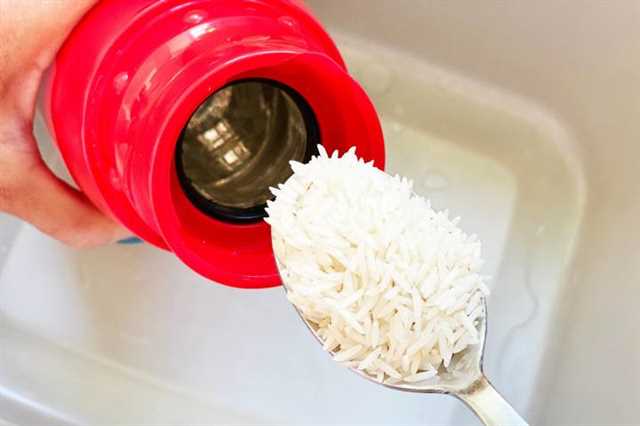
One of the easiest and most effective ways to clean a flask is by using bicarbonate of soda, also known as baking soda. This versatile substance has excellent cleaning properties and can remove stains and odors from your flask.
- Start by filling your flask with warm water.
- Add a tablespoon of bicarbonate of soda and stir until it dissolves.
- Let the solution sit in the flask for a few minutes.
- Then, empty the flask and rinse it thoroughly.
- Finally, wash the flask with warm soapy water and rinse again.
Vinegar
Vinegar is another great cleaning agent that can help remove limescale and stains from your flask. It is a natural and safe cleaning option, especially for glass flasks.
- Fill your flask with vinegar, covering any stained or limescale areas.
- Let the vinegar sit in the flask for a few hours or overnight.
- Empty the flask and rinse it thoroughly.
- Wash the flask with warm soapy water and rinse again.
Rice
Rice can be a helpful cleaning tool for narrow and insulated flasks that are difficult to clean with traditional methods. The rice acts as an abrasive, scrubbing away dirt and stains.
- Fill your flask about halfway with warm water.
- Add a tablespoon of rice and a few drops of dishwashing liquid.
- Close the flask and shake it vigorously, allowing the rice to scrub the interior.
- Empty the flask, rinse it thoroughly, and wash it with warm soapy water.
Remember to always take care when cleaning your flask, as some methods may not be suitable for certain materials or types of flasks. Additionally, be sure to follow any specific instructions or guidelines provided by the manufacturer to ensure the longevity of your flask and to prevent any damage.
Using Bicarb to Clean a Flask

In this article, we will discuss using bicarbonate of soda (bicarb) as a cleaning agent for your flask. Bicarb has been used for many years as a natural cleaner, and it is a versatile product that can be found in almost every household. Its cleaning properties are effective and can easily remove stains, odor, and limescale from your flask.
Gather the Ingredients
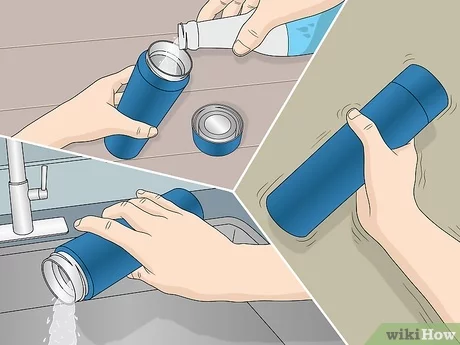
To start, you will need the following:
- 1 tablespoon of bicarbonate of soda
- Warm water
- A cleaning brush or sponge
The Cleaning Process
Follow these steps to clean your flask using bicarb:
-
First, make sure your flask is empty and rinse it out with warm water. This will remove any leftover contents and make the cleaning process easier.
-
Next, add 1 tablespoon of bicarbonate of soda to the flask. Bicarb is a mild abrasive and will help remove stains and limescale without scratching the flask’s surface.
-
Fill the flask about halfway with warm water. This will create a solution that will help break down any residue or bacteria.
-
Use a cleaning brush or sponge to scrub the inside of the flask. Pay extra attention to the bottom and sides where stains and limescale tend to accumulate. If there are any tough stains or limescale, mix a little more bicarb with water to create a paste and apply it directly to the problem area.
-
Once you’ve thoroughly scrubbed the flask, pour out the solution and rinse with warm water.
-
Finally, dry the flask completely before using it again. Leaving any moisture can lead to the growth of bacteria or the development of limescale.
Using bicarb to clean your flask is a great way to ensure it stays fresh and odor-free. The mild abrasive properties of bicarb make it an effective and gentle cleaner that is safe to use on glass and other materials.
Note: If your flask has a dishwasher-safe label, you can also place it in the dishwasher for a thorough cleaning. However, be sure to still take care of any stains or limescale with the bicarb method mentioned above.
So, next time you need to clean your flask, reach for the bicarbonate of soda and get to work! You’ll be amazed at how clean and fresh your flask will be.
Using Rice to Clean a Flask

Cleaning a flask can be a bit challenging, especially if it is an insulated thermos flask. However, with a little care and the right technique, you can keep your flask clean and ready for use.
One easy and effective way to clean a flask is by using rice. Rice is a great cleaning agent that can help remove stains and odor from the flask. Here’s how you can use rice to clean your flask:
- Wash the flask: Before using rice to clean your flask, make sure to wash it thoroughly. This will help remove any leftover liquid or residue.
- Add rice to the flask: Fill your flask with some uncooked rice. The amount of rice you need will depend on the size of your flask.
- Shake it up: Close the flask and shake it vigorously for a few minutes. The rice will act as an abrasive and help scrub away any stubborn stains or residues.
- Remove the rice: Once you’re done shaking, empty the rice from the flask. You can do this by either pouring it out or using a small brush or spoon to scoop it out.
- Rinse the flask: After removing the rice, rinse the flask with warm water to get rid of any rice particles left behind.
- Additional care: If there are any stubborn stains or odor remaining, you can repeat the process using fresh rice or try other cleaning methods mentioned in this article.
Cleaning a flask with rice is a simple and effective way to keep it clean. It is also a safer alternative to using harsh chemicals or abrasive substances that may damage the flask. Just remember to always follow the manufacturer’s care instructions, especially if your flask is dishwasher-safe.
By following the above steps and using rice to clean your flask, you can ensure that it stays in great condition for years to come. Take care of your flask and it will take care of your beverages!
Using Vinegar to Clean a Flask
Vinegar is a versatile and effective cleaning agent that can be used to clean a variety of household items, including flasks. It offers an easy and affordable solution for removing stains, limescale, and bacteria from your flask. Here are some simple steps to follow when using vinegar to clean your flask:
- Make sure your flask is empty. If there are any remaining liquid or contents in the flask, pour them out before starting the cleaning process.
- Fill the flask halfway with warm water. This will help to dilute the vinegar and make it more effective in cleaning.
- Add vinegar to the flask. Depending on the size of your flask, you may need to add several tablespoons or a cup of vinegar. The acid in the vinegar helps to break down stains, limescale, and bacteria.
- Place the stopper back on your flask and give it a good shake. This will help to distribute the vinegar solution evenly inside the flask.
- Allow the vinegar solution to sit in the flask for at least 10-15 minutes. This will give the vinegar enough time to work its magic and break down any stains or bacteria.
- After the recommended time, empty the flask and rinse it thoroughly with warm water.
- If there are stubborn stains or limescale remaining, you can use a bottle brush or a long-handled brush to scrub the inside of the flask gently.
- Rinse the flask again to remove any remaining vinegar solution.
- Finally, let the flask air dry or use a clean and dry cloth to wipe it completely before using it again.
Using vinegar to clean your flask is a natural and effective way to maintain its cleanliness and quality. It is important to note that vinegar should not be used on flasks made of certain materials, such as aluminum or copper, as it can cause damage. Additionally, always check the manufacturer’s instructions for specific cleaning advice and guidelines for your flask.
Thermos: Over 100 Years of Expertise
Thermos flasks have been around for over 100 years, providing people with the ability to keep their drinks hot or cold for extended periods of time. The key to their success lies in the design and construction of the flask, particularly the stopper.
Thermos flasks are equipped with a stopper that creates a vacuum seal, preventing air from entering or leaving the flask. This is important because it helps to maintain the temperature of the contents inside. Without this seal, heat would escape or enter the flask, ultimately affecting the temperature of the drink.
Over time, thermos flasks can develop stains or odors. This is particularly common when they are used to hold coffee or other beverages for long periods. To eliminate these stains and odors, there are several easy and effective methods that you can use.
Use Baking Soda and Vinegar
One of the most effective ways to clean a thermos flask is to use a combination of baking soda and vinegar. Start by rinsing the flask with warm water to remove any loose debris. Then, add a tablespoon of baking soda into the flask, followed by a cup of white vinegar. Allow the mixture to sit in the flask for several minutes, then use a brush or sponge to scrub away any stains or odors. Rinse thoroughly and your flask will be clean and odor-free.
Try Denture Tablets
If you don’t have baking soda or vinegar on hand, denture tablets can also be effective for cleaning your thermos. Simply fill the flask with warm water and drop in a denture tablet. Let it dissolve and sit for a few hours, or overnight for the best results. The effervescent action of the tablets will help to break down any stains or odors. After soaking, rinse the flask thoroughly and it will be as good as new.
Use Rice or Salt
Rice or salt can be used as a mild abrasive to clean stains and odors from the bottom of your thermos flask. Simply fill the flask with warm water and add a tablespoon of rice or salt. Close the flask and shake it vigorously for a few minutes. The rice or salt will help to scrub away any stubborn stains or odors. Rinse thoroughly and your flask will be clean and fresh.
Additional Tips
Here are a few additional tips to keep in mind when cleaning your thermos flask:
- Always wash your thermos flask immediately after use to prevent stains and odors from setting.
- When using denture tablets or baking soda and vinegar, allow the mixture to sit in the flask for several minutes to maximize their cleaning power.
- For coffee stains, try soaking the flask in warm, soapy water for a few hours before using one of the cleaning methods mentioned above.
- Do not use harsh cleaners or abrasive substances on your thermos flask, as they may damage the flask or affect the taste of your drinks.
By following these tips and methods, you can keep your thermos flask clean and odor-free, ensuring that your drinks stay hot or cold for longer periods.
